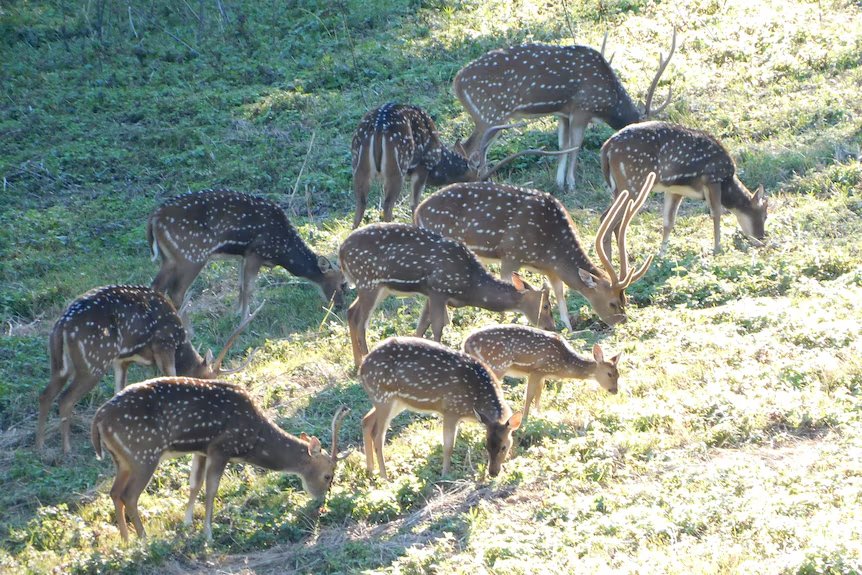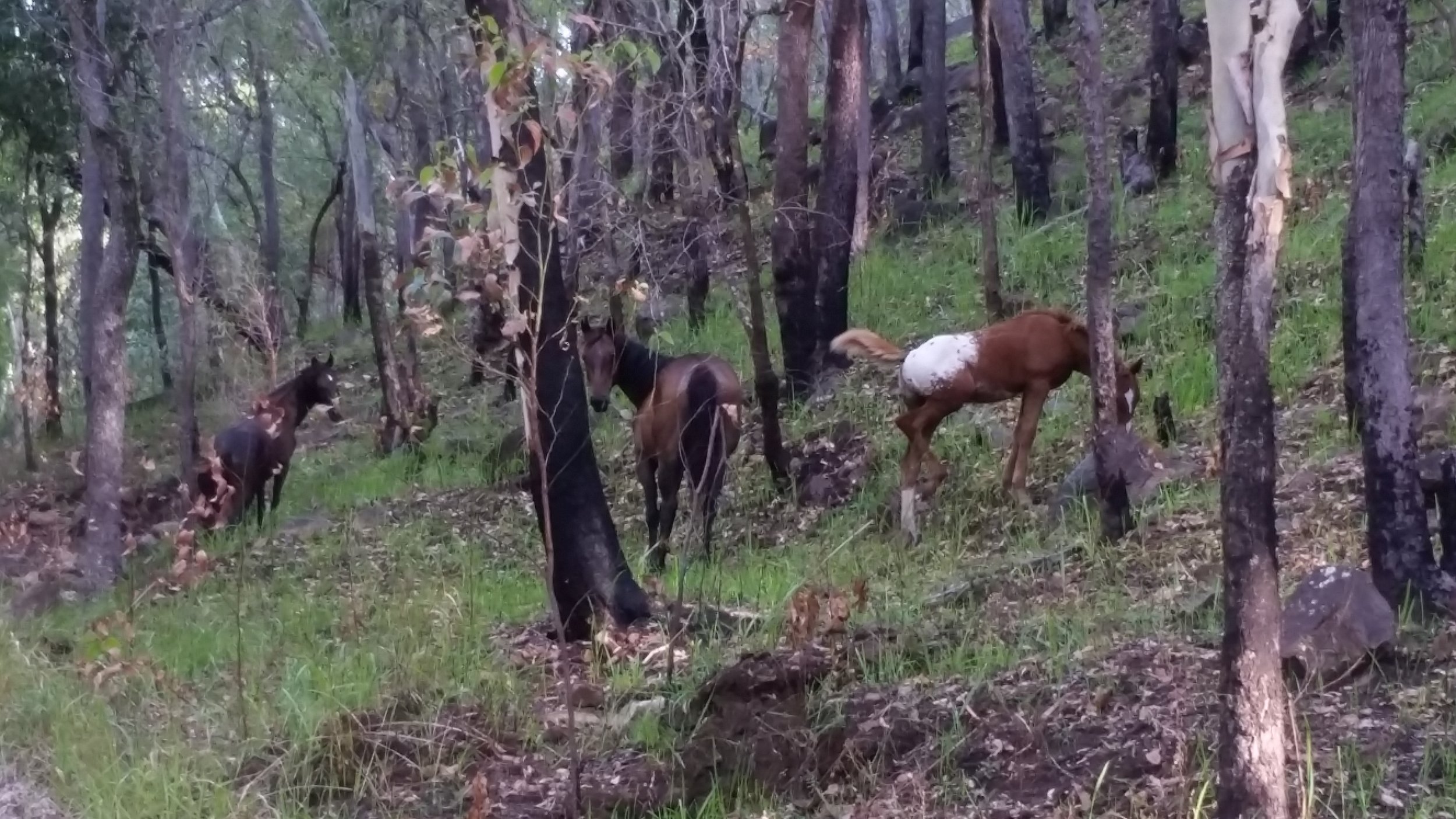
Feral Animal Relocation Services Program
-

No Harm Sedation
No harm sedation in practice involves the careful administration of sedatives to animals under strict veterinary Guidance and use of airborne drone precision and execution of sedative darts via highly accurate delivery systems.
This approach ensures that the animal experiences minimal stress during procedures, while also safeguarding its health and wellbeing.
Veterinarians will typically assess the animal's medical history, breed, age, and overall condition before recommending the type and amount of sedation. The chosen sedative must be safe and effective for the specific species and situation maintaining good sedation over the relocation period. Monitoring during the sedation process is crucial to quickly address any adverse reactions or changes in the animal’s condition.
This is the most efficient and safe approach to ecologically relocating large animals such as wild Deer, Horses and Kangaroo's etc.
-

Relocation
Relocating feral animals to a new habitat requires a careful and strategic approach to ensure the safety of both the animals and the local ecosystem. Here are the key steps to undertake this process effectively:
1. Assess the Situation
Identify the Species: Determine the type of feral animals involved and understand their habitat needs and behaviours.
Evaluate the Environment: Examine the original location and potential new habitats for suitability, including food availability, shelter, and space.
2. Obtain Necessary Permits
Check with local wildlife authorities and obtain any permits required for the relocation. Adhering to legal and ethical protocols is crucial.
3. Prepare the New Habitat
Ensure the new location is appropriate and not occupied by existing wildlife that may compete for resources. This area should also be monitored for potential human-animal conflicts.
4. Capture Techniques
Use humane sedation technique's to safely capture feral animals. Ensure that animals are checked frequently to minimise stress.
5. Transport Safely
During transportation, ensure that animals are kept in secure, well-ventilated containers. Maintain a calm environment to reduce stress during the journey.
6. Release Strategy
Upon reaching the new habitat, release the animals in a safe area away from human activity. Monitor their re-entry into the ecosystem to ensure they adapt successfully.
7. Post-Release Monitoring
Conduct follow-up observations to assess the health and integration of the animals into their new surroundings. This may involve tracking their movements and behaviours to ensure they are thriving.
Conclusion
Relocating feral animals is a complex yet vital task that benefits from thorough planning and consideration of both animal welfare and ecological balance. Engaging with us as professionals with experience in wildlife management can greatly enhance the success of relocation efforts.
-

Conservation of Forestry and Farmlands
Conservation of Forest and Farmland from Feral Animals
The conservation of Australia’s forests and farmlands is increasingly threatened by the impact of feral animals. These species, often introduced through human activity, can cause significant harm to native ecosystems and agricultural productivity. Effective management and conservation strategies are essential to mitigate their effects and protect our natural resources.
Understanding the Impact
Feral animals, such as feral cats, rabbits, horses, kangaroo's and deer, disrupt local biodiversity. They compete with native species for food and habitat, prey on wildlife, and contribute to soil degradation. In agricultural settings, feral pigs and goats can damage crops and infrastructure, leading to substantial economic losses for farmers.
Challenges in Management
Controlling feral animal populations presents various challenges. These include identifying the most effective control methods, balancing ecological outcomes, and ensuring compliance with regulatory frameworks. Additionally, public perception and attitudes towards feral animal control can complicate management efforts.
Strategic Approaches
Integrated Control Programs: Combining relocation management techniques—can lead to better outcomes. Stakeholders can work with us to control feral stocks with our developed programs that consider ecological sustainability and economic viability.
Community Engagement: Involving local communities in conservation efforts can foster a sense of stewardship. Educational programs highlighting the importance of protecting native wildlife and managing feral populations can encourage collective action to use our highly accurate and innovative services.
Regulatory Support: Legislation that supports feral animal management and conservation initiatives is critical. Implementing policies that restrict the introduction and spread of feral species can help maintain the integrity of native ecosystems.
Conclusion
The threat posed by feral animals to Australia’s forests and farmlands cannot be underestimated. A multi-faceted approach that combines technology, and strong regulatory frameworks is essential for effective conservation efforts. By proactively addressing the challenges posed by these invasive species, we can protect our rich natural heritage and support sustainable agricultural practices for future generations.
Protect our Native Animals.
Protecting native animals from feral animal invasion combines education, strategic management, and innovative technology. Feral animals such as deer, horses, kangaroo’s, cats, foxes, and rabbits pose significant threats to Australia’s unique biodiversity. These invasive species compete for resources, prey on native wildlife, and contribute to habitat degradation.
Understanding the Threat.
Native animals have adapted in isolation, leading to a fragile ecosystem that is ill-equipped to cope with feral invaders.
Effective Strategies
Monitoring and Assessment: Utilising drones for aerial surveying can provide crucial data on feral animal populations. Hyperspectral imaging technology can help identify habitat changes and assess the health of ecosystems, enabling targeted conservation efforts.
Control Programs: Implementing humane control methods, such as sedated relocation or targeted poisoning programs, can help manage feral species. It's vital that these methods are carried out in compliance with local regulations and ethical considerations.
Community Engagement: Raising awareness and involving local communities can support conservation efforts. Educational programs should inform residents about the importance of protecting native species and the detrimental impact of feral animals.
Restoration of Habitats: Restoring native habitats can create a more resilient environment that supports biodiversity. This can involve replanting native vegetation and rehabilitating ecosystems damaged by feral species.
Legislation and Policy: Advocating for stronger laws and policies regarding the control of feral animals is crucial. Support for initiatives that fund research and management programmes can foster collaboration between governmental and non-governmental organisations.
Conclusion
The fight against feral animal invasion is ongoing, but with a coordinated approach that incorporates technology like drone innovative techniques, we can protect Australia’s native wildlife. It is imperative to act now to safeguard our unique ecosystems for future generations.


